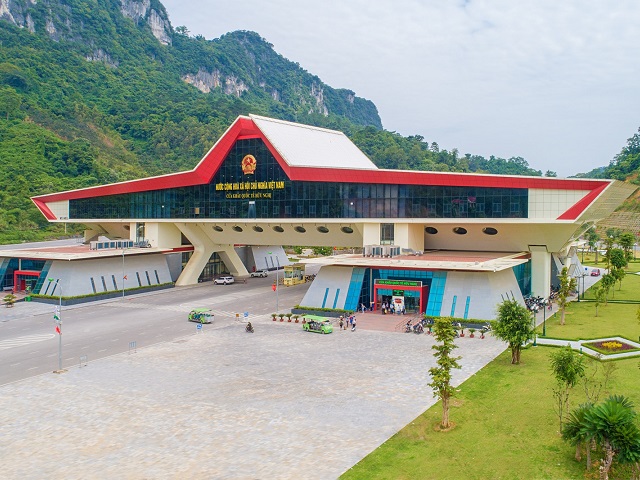The Smart Border model is a modern border control and management system that utilizes advanced technologies such as artificial intelligence (AI), Internet of Things (IoT), biometrics, data analytics, and blockchain to optimize the flow of people and goods across borders, ensuring security and efficiency.
Smart Borders address the long-standing issue of cargo congestion at border gates, reducing clearance costs and creating a more conducive business environment for import-export enterprises. This model also increases state budget revenues and supports anti-smuggling and anti-commercial fraud efforts, while combating counterfeit and substandard goods. Additionally, it contributes to the stabilization and improvement of livelihoods for border residents, maintaining political security, social order and safety, and upholding national border sovereignty.
The current customs clearance process in Vietnam faces significant challenges, particularly at the Huu Nghi (Lang Son) international border gate, where the traditional clearance model has reached its maximum capacity of approximately 1,350 vehicles per day, falling short of actual demands.
In February 2022, Lang Son became the first province in Vietnam to pilot the Smart Border model. As a result, the province’s import-export turnover significantly increased from $17.5 billion in the 2016-2020 period to a record-breaking $66.4 billion in 2024, accounting for nearly one-third of the total trade value between Vietnam and China.
In August 2024, the Prime Minister approved the proposal to pilot the construction of a “Smart Border” at the Huu Nghi (Vietnam) – Huu Nghi Quan (China) international border gate, marking a new phase in the modernization of customs procedures in Lang Son.
The Smart Border project is expected to increase clearance capacity by four to five times the current level by 2030, with 3,000-3,500 vehicles cleared daily at the 1119-1120 marker area and 2,000-2,500 vehicles at the 1088/2-1089 marker area. This will result in significant logistics cost savings, estimated at over VND 4,900 billion by 2027 and more than VND 9,800 billion by 2030.
The pilot project for the construction of a Smart Border at the dedicated cargo transport routes in the 1119-1120 and 1088/2-1089 marker areas is expected to transform Lang Son into a vibrant and modern trade hub between Vietnam, China, and ASEAN countries.
The implementation of the Smart Border project is divided into two phases. Phase 1, from Q3 2024 to Q2 2026, focuses on infrastructure development, including the signing of an agreement between the Lang Son Provincial People’s Committee and the People’s Government of the Guangxi Zhuang Autonomous Region, China, on a pilot mechanism for the construction of a Smart Border. This phase also involves the construction of state-owned infrastructure and the mobilization of capital from enterprises, along with the development of detailed operation guidelines and procedures. Additionally, there will be a focus on synchronizing infrastructure and information databases with China for the pilot operation of the Smart Border.
Phase 2, from Q3 2026 to Q3 2029, will involve the pilot operation of the Smart Border, with regular inspections and evaluations to address any issues that arise. This phase will also see the continued investment and expansion of border infrastructure, particularly in terms of cargo yards, to ensure compatibility with the Chinese side.
Initially, the pilot project will focus on the clearance of fruit and electronic component exports from Vietnam and ASEAN countries, as well as imports of electronic components from China. During the pilot period, Lang Son will continue to negotiate with the Chinese side to expand the range of import-export goods to ensure the effectiveness and success of the project.

Smart Border in Lang Son.
|
Many countries worldwide have been actively developing Smart Border models to enhance border security and facilitate international trade. The European Union (EU), for example, has introduced the “Smart Borders Package,” scheduled for implementation in 2025-2026. This package aims to facilitate border control, improve internal security through stricter identification at external borders, and help detect overstayers within the Schengen area.
China has proposed the “Smart Customs, Smart Borders and Smart Connectivity” (“3S”) initiative, which focuses on encouraging technological innovation and optimizing control measures to modernize customs management and capacity. The initiative also promotes information sharing, joint operations, and risk management among customs and border agencies, as well as smart connectivity that ensures security and facilitates trade through the interoperability and compatibility of systems and standards, along with the cooperation of stakeholders in the global supply chain.
What lessons can Vietnam draw from these global initiatives?
Firstly, the application of technologies such as AI, IoT, blockchain, biometrics, and big data analytics is an inevitable trend in modern border management. Vietnam needs to invest in technological infrastructure and develop a high-quality workforce capable of operating and advancing these systems.
Secondly, international cooperation plays a crucial role in the development of Smart Borders. Vietnam should continue to strengthen collaboration with neighboring countries to ensure the compatibility and interoperability of systems.
Thirdly, strong mechanisms for privacy protection and information security are essential when implementing Smart Border systems. The collection and processing of biometric and personal data require stringent security measures.
Lastly, the development of Smart Borders should be viewed as part of a broader strategy for digitalization and the advancement of digital trade. According to the WTO, digitally delivered services have shown significant growth in value since 2005, with an average annual increase of 8.1% between 2005 and 2022, outpacing the growth of merchandise trade. Vietnam should seize this opportunity to boost its digital trade.
Mastering the Art of Persuasion: The Ultimate Guide to Writing Compelling Copy and Captivating Customers
SHS Hanoi-Saigon Securities Corporation (HNX: SHS) has announced that April 25th is the deadline for shareholders to register to receive a substantial 20% dividend payout in cash and stocks. This announcement underscores SHS’s unwavering commitment to protecting shareholders’ interests and enhancing their investment value.
The Secretary-General’s Speech at the Conference on Breakthroughs in Science and Technology Development
General Secretary To Lam emphasized that science, technology, innovation, and digital transformation must be regarded as the “golden key” and vital factors in overcoming the middle-income trap and the risk of falling behind. These areas are also crucial in realizing our nation’s aspirations for strength and prosperity.
The Race to Build Ho Chi Minh City’s Financial Hub: Unlocking Potential Amid Challenges
As Vietnam’s economic powerhouse, Ho Chi Minh City is ambitiously striving to establish itself as an international financial hub. This strategic vision is aimed at bolstering the city’s economic prowess and attracting global investment, thereby elevating its status on the world stage. This endeavor is not merely a municipal aspiration but a pivotal component of the nation’s overarching development strategy, reflecting its commitment to fostering sustainable growth and prosperity.





















